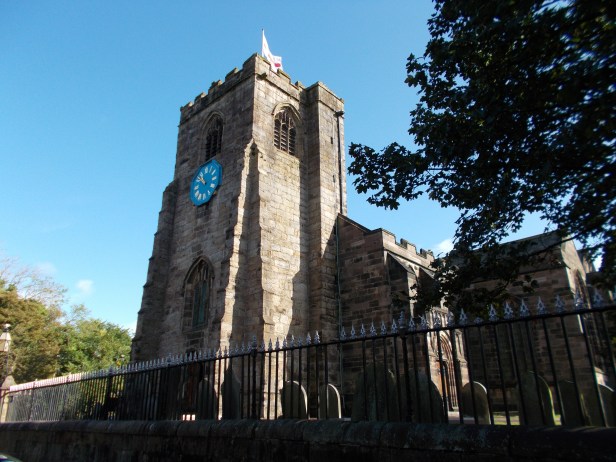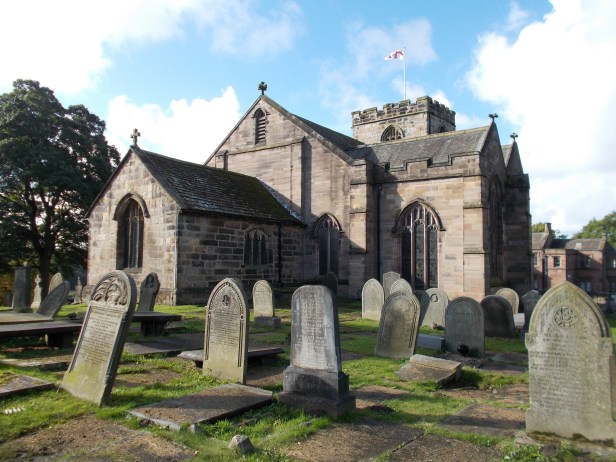St Leonard’s Parish Church at Walton-le-Dale stands atop a steep promontory . The first historical reference to a church on this spot comes from documents dating from 1166, but there could well have been one here in Saxon times.

The Influence of Whalley Abbey
From the 1200s the church was administered by Whalley Abbey. In 1283 Robert Banastre, lord of the manor of Walton, gave the Whalley monks ten acres of land adjoining the chapel grounds, and the right to pasture in the township. Thirty pigs were allowed to graze in Walton Woods, and the right to remove timber for building or for burning also granted. The abbey also had a farm, known as a grange, at Walton. When the monasteries were destroyed by King Henry VIII, the church land was sold to the Assheton family of Cuerdale.
Catholic and Protestant Disharmony
The powerful local Langton family were benefactors of the church during the Tudor times. Like many local landowning families, they may well have had to hide their Catholic sympathies. Sir Thomas Langton kept his own private chapel for worship at Walton Hall perhaps for this reason, but before his death in 1569 he indicated his wishes to buried at the church.
When the saying of mass was outlawed, the Earl of Derby in 1559 ordered the arrest Thomas Heavenson the curate carrying out the service. The informer, Thomas Clayton, had to be given protection from his neighbours, fifty of which had attended the worship.
Sir Thomas Langton’s grandson, also named Thomas, may have wished to appear a Protestant but, in 1592, his Catholic sympathies were informed upon by a spy named Dingley to Lord Burghley, Queen Elizabeth’s spymaster. Lord Burghley stated Langton would “be more determined than any to take Dingley’s life if only he knew what our informer had said of him“. Lord Burghley’s map of Lancashire marked Thomas Langton’s home with a cross, which was done for all the known Catholics in the region.
A strange link between Langton and the church was written about by his contemporary, John Weaver. Weaver states that Edward Kelley, the necromantic fraudster and alchemist, came to St Leonard’s churchyard with Langton’s servant, to raise the corpse of a dead man and speak to a demon through it. The purpose of this action was to find out what the future held for Langton and when he would die. Although some dismiss the story as folklore, there are good reasons to believe that the events did occur, as described on our page here.

A Duel at Knot Lane
Knot Lane lies close by to St Leonards, and it was here, in the early 1700s, that a duel was fought. Samuel Crooke and his servant were riding their way up Knot Lane when they came across William Buckley and his servant, also on horseback. The men had a history and an ensuing altercation took place, with blows being exchanged. Crook and Buckley then dismounted and set about each other with swords. After a few minutes of fighting, Buckley managed to kill Crook. He then “saluted him with his sword, kissed him, and fled”.
Crook’s gravestone lies in the chancel of St Leonard’s. It states: Here lies the body of Samuel Crooke esquire. He was killed going to the Assizes by Mr William Buckley, to the great grief of his family and friends August 9th 1722. He was an affectionate husband, a useful magistrate and a faithful subject to the best of kings. Married Anna daughter of Charles Hoghton Baronet and left issue a son born two months after his death. (Author’s Note: The text has been modernised for this piece).
In late Georgian times, a regular sight at the church would be a group of children dressed in brown coats with yellow cuffs and collars. There were apprentices who worked at a Penwortham cotton mill known as Vernon’s. The owner John Watson had acquired them from orphanages in London. When Watson’s firm went bankrupt in 1807, they were heartlessly turned out into the fields and left to fend for themselves.
Expansion
A growing congregation meant that the church was no longer large enough for its parishioners. Accordingly, the nave was demolished and a new much wider one was built in 1798. Just seventeen years later, galleries were added to give further space to the swelling ranks. These were supported by cast iron pillars cast at the local foundry in Higher Walton, which usually supplied them to cotton mills. The wealthy sat high up in the gallery, and the poorer people sat in the seats below. Transepts were added the year after. More restoration occurred in 1855. The box pews were removed, and a reading desk and pulpit put in place on either side of the chancel arch.
The Nave is Rebuilt
In 1902, an annual clean revealed the roof was found to have serious structural faults. Three pitch pine poles were rapidly put into place to make sure the roof did not collapse. The nave needed a rebuild.
John Pollard Seddon, a well known architect, was appointed to carry out repairs and rebuilding. He would not normally have become involved with the restoration of a local church, but his daughter Maude was married to Walter de Hoghton Lea Birch of Walton Hall. Seddon was friends with famous Pre Raphaelites including Gabrielle Dante Rossetti, Holman Hunt and Ford Maddox Brown. He was a big believer in preserving as much as he could of original features, and using local materials in any restoration.
Large donations came in from Richard Calvert, the owner of nearby Flatts Mill, who gave £5000, and Henry Calvert who pledged £1000. Parishioners donated on a weekly basis. To reduce expense, it was hoped that the original walls of the nave could be saved, but on inspection they were not in a good enough condition and discovered to be standing on the original Tudor foundations. During the work, parishioners packed into the small chancel to attend more frequent, but shorter, services.
An oak hammer beam roof was constructed and three windows from the old nave were able to be reinstated in the new one. The chancel arch was widened, a new floor installed, new seating and a new organ gallery put in place. The installation of central heating ensured the parishioners would be warm during the winter months. The rebuild and restoration was the last work that John Pollard Smith carried out and he died a few months before the official reopening, in 1906.

What Can be Seen Today
The small chancel is the oldest part of the building, with an Early English doorway which dates to the 1200s. It contains memorials to the Asshetons of Cuerdale and Hoghtons of Walton. One of the memorial plaques displays Sir Charles Hoghton’s wishes from 1710 “This plate of brass is here fixed to intimate to all persons whatsoever that it was his desire nobody for time to come should be buried under the seat or pew, belonging to the Hoghtons, where his remains are interred except the Lady Hoghton, his relict, if she so desire”. Also of note is the memorial to Major-General Daniel Hoghton, the hero of Alburera. Highly regarded by Wellington, his sword, sash and belt were found beneath the floor in 1863. More of his memorabilia can be seen at nearby Hoghton Tower.
The church tower dates from the late 1400s to early 1500s. At one time, a large clock face had been painted directly onto the tower, measuring 16 feet in diameter. This was replaced in 1826 by a smaller wooden one, but Edward Baines writing four years later complained that this still looked far to large and spoilt the look of the tower. Part of this wooden face may have been cut up and reused, with a section now acting as a door into the clock chamber, the Roman numerals IX, X, XI, XII still clearly visible. The clock had only one hand and had to be wound every day. The blue face of the present clock is still rather big in proportion to the tower, but perhaps all of the clock faces have been large so they could be seen at a distance.
The length of the nave may have changed little over the centuries, pinned between the old chancel and tower, but its width has changed considerably and is now very wide and spacious. A large organ dominates and on our visit was impressively being played at full volume. The stained glass is in the arts and craft style and there are carved wooden angels playing instruments on the hammer beams of the roof.
The churchyard reveals fantastic views over Walton-le-Dale and, if the trees were removed, down onto the River Ribble. The promontory the church stands on is called Walton Law. The word ‘law’ is a corruption of the Saxon word ‘lowe’ which can mean a steep hill, or more interestingly a Bronze Age burial site. In the Peak District of Derbyshire, most of the lowes that have been dug have contained cremated remains and grave goods from the Bronze Age. It could well be that this too was once such a site, over two thousand years before the first church was built.
Site visited by A. and S. Bowden 2022
Access
St Leonard’s is open to the public most days. There is a car park in front of the church, just off Church Brow.
On this site
The Strange Tale of Edward Kelley
Nearby, just a few minutes away on foot
Walton-le-Dale Lost Military Roman site
Just a short drive away
References
Saint Leonard Walton-le-Dale, David Hunt (2006). This excellent full colour booklet is available in the church. It is written by David Hunt, local historian and recently retired curator of the South Ribble Exhibition Centre.
historyofparliamentonline.org/volume/1558-1603/member/langton-thomas-1561-1605
Comments are closed.